在数学中,如果给定g的输出返回给定f的输入值,则将一个函数(例如f)称为另一个函数(例如g)的逆函数。此外,这对于g的域co-domain(范围)中的每个元素都必须成立。例如,假设x和y是常数,如果g(x)= y和f(y)= x,则函数f被称为函数g的逆。换句话说,如果函数f:A⇢B是一个一,并且在函数或双射函数,则由g:B⇢A定义的函数称为函数f的逆。逆函数也称为反函数。函数的倒数由f -1表示。
f(g(x)) = g(f(x)) = x
在此,f和g是反函数。
查找f的逆的过程:
- 检查一对一函数。
- 如果可逆,则在f(x)的定义中互换x和y。
- 根据x查找y。
- 获得的y是从B⇢A定义的f的倒数。
Example: f(x) = ex
y = ex
Inverse of f(x) will be obtained by y ↔ x
x = ey
y = ln x
Now, ex and ln x are inverse function of each other.
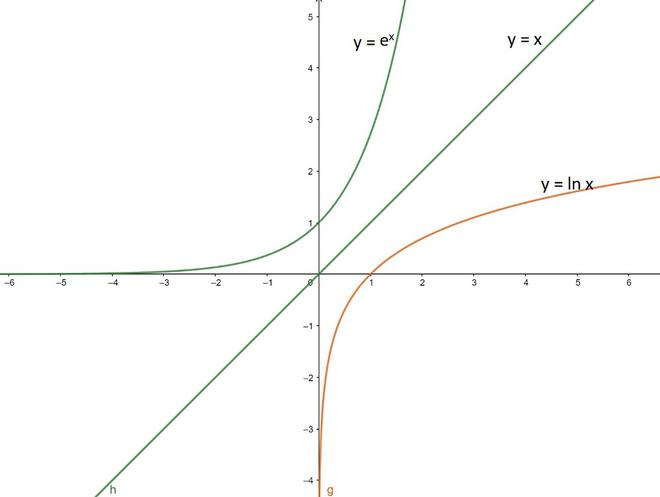
Inverse functions ex and ln x are symmetry about y = x.
反函数的导数
我们已经知道逆函数是什么,所以现在我们要找到逆函数的导数。因此,如果函数f(x)是在间隔上定义的连续一对一函数或双射函数,以免说I,那么它的逆函数也是连续的,并且如果函数f(x)是可微函数,则其逆也是一个微分函数。
g'(x) = ![]()
在这里,f和g是反函数。它被称为逆函数定理。
Proof:
Let us considered f and g be the inverse functions and x is present in the g domain, then
f(g(x)) = x
Differentiate both side with respect to x
![]()
Now solve the LHS using chain rule we get
f'(g(x))g'(x) = 1
Now solve for g'(x):
g'(x) = ![]()
因此,求解了反函数的导数。
例1:f(x)= e x ,检查条件是否成立。
解决方案:
As, f(x) = ex
y = ex
x = ln y
g(x) = f-1(x) = ln x
Now,
f'(x) = ![]() (ex) = ex
(ex) = ex
g'(x) = ![]() (ln x) =
(ln x) = ![]()
g'(f(x)) = ![]()
![]() = ex
= ex
Hence,
f'(x) = ![]() , holds true.
, holds true.
示例2:令f(x)= ![]() x 3 + 3x – 4,令g为f的反函数,其中f(-2)= -14。求g’(-14)
x 3 + 3x – 4,令g为f的反函数,其中f(-2)= -14。求g’(-14)
解决方案:
f'(x) = ![]() (3x2) + 3
(3x2) + 3
According to eq(1).
![]()
As, f(x) = g-1(x) and f(-2) = -14
then g(-14) = -2
x = -14
g'(-14) = ![]()
g'(-14) = ![]()
f'(-2) = ![]() (3(-2)2) + 3
(3(-2)2) + 3
f'(-2) = ![]() + 3
+ 3
f'(-2) = 9
then, g'(-14) = ![]()
如何从表中找到反函数的导数?
让我们借助示例来讨论这个概念。因此,让我们假设g和f是反函数,下表列出了f,g和f’的一些值。
| x | f(x) | g(x) | f'(x) |
|---|---|---|---|
| 2 | 4 | 8 | |
| 8 | 3 | 2 |
我们必须找到g’(2)。从问题中可以看出,f和g是反函数。这意味着如果我们有两个集合,现在让我们假设第一个集合是f的域。因此,在这个集合中,如果我们从某个x值开始,则f会将那个x映射到另一个值f(x)(这是函数f的用法)。现在我们知道g是f的倒数,因此g使我们回到第一个集合(这是对函数g的使用)。
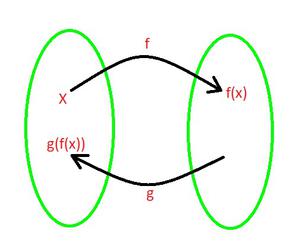
因此我们得到
g(f(x))= x…(i)
f(g(x))= x…(ii)
两者都有效。
从等式(ii),我们有
f(g(x))= x
现在区分双方wrtx我们得到
![]()
现在在LHS上我们应用链式规则,现在我们得到
f’(g(x))g’(x)= 1
g'(x) = ![]()
现在我们将找到g’(2)的值
g’(2)= ![]()
从表中我们得到g(2)的值
g’(2)= ![]()
从表中我们得到f’(8)的值
g’(2)= ![]()
g’(2)= 2
因此,g’(2)的值= 2。
如何找到反三角函数的导数?
我们注意到反三角函数是连续函数。现在,我们使用第一原理和链式规则来找到这些函数的派生:
1.由f(x)= sin –1 x给出的f的导数。
From first principle
f(x) = sin–1 x and f(x+h) = sin–1 (x+h)
![Rendered by QuickLaTeX.com \frac{d}{dx}(f(x)) = \lim_{h\to0} \frac{f(x+h)-f(x)}{h} \\ = \lim_{h\to0} \frac{sin^{-1}(x+h)-sin^{-1}x}{h}\\ = \lim_{h\to0} \frac{sin^{-1}[(x+h)\sqrt{1-x^2} - x\sqrt{1-(x+h)^2}]}{h}](https://mangdo-1254073825.cos.ap-chengdu.myqcloud.com//front_eng_imgs/geeksforgeeks2021/Derivatives%20of%20Inverse%20Functions_26.jpg)
Using the formula,
sin–1 x – sin–1 y = sin-1(x ![]() – y
– y ![]() )
)
![Rendered by QuickLaTeX.com = \lim_{h\to0} \frac{sin^{-1}[(x+h)\sqrt{1-x^2}-x\sqrt{1-(x+h)^2}]}{(x+h)\sqrt{1-x^2}-x\sqrt{1-(x+h)^2}} \times \frac{(x+h)\sqrt{1-x^2}-x\sqrt{1-(x+h)^2}}{h}](https://mangdo-1254073825.cos.ap-chengdu.myqcloud.com//front_eng_imgs/geeksforgeeks2021/Derivatives%20of%20Inverse%20Functions_29.jpg)
As
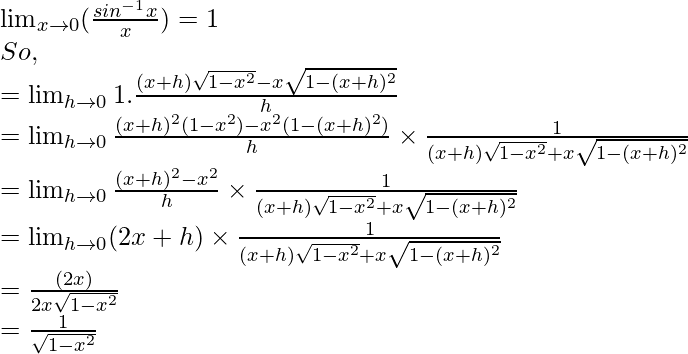
Hence
![]()
From chain rule
y = sin-1x
sin y = x
Differentiating both sides w.r.t x, we get

As

2.由f(x)= cos –1 x给出的f的导数。
From first principle
f(x) = cos–1 x and f(x+h) = cos–1 (x+h)

As

By using the previous result
![]()
Hence,
![]()
From chain rule
y = cos-1x
cos y = x
Differentiating both sides w.r.t x, we get
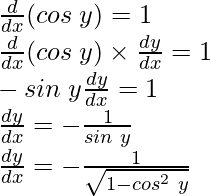
As

3. f的导数由f(x)= tan –1 x给出。
From first principle
f(x) = tan–1 x and f(x+h) = tan–1 (x+h)

As
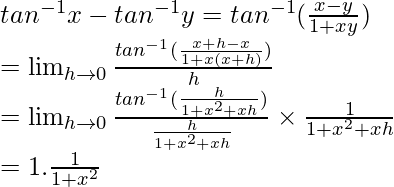
Hence
![]()
From chain rule
y = tan-1x
tan y = x
Differentiating both sides w.r.t x, we get
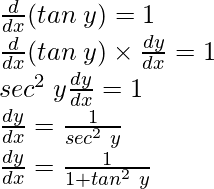
As
tan y = x dy/dx = 1/1+x2
4.由f(x)= cot –1 x给出的f的导数。
From first principle
f(x) = cot–1 x and f(x+h) = cot–1 (x+h)

As

![]()
Hence
![]()
From chain rule
y = cot-1x
cot y = x
Differentiating both sides w.r.t x, we get
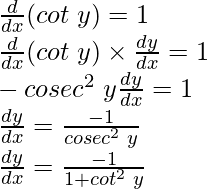
As
cot y = x dy/dx = -1/1 + x2
5.由f(x)= sec –1 x给出的f的导数。
From chain rule
y = sec-1x
sec y = x
Differentiating both sides w.r.t x, we get

If x > 1, then y ∈ (0, π/2)
∴ sec y > 0, tan y > 0 ⇒ |sec y||tan y| = sec y tan y
If x < -1, then y ∈ (π/2,π)
∴ sec y < 0, tan y < 0 ⇒ |sec y||tan y| = (-sec y) (-tan y) = sec y tan y

As
sec y = x
![]()
6.由f(x)= cosec –1 x给出的f的导数。
From chain rule
y = cosec-1x
cosec y = x
Differentiating both sides w.r.t x, we get

If x > 1, then y ∈ (0, π/2)
∴ cosec y > 0, cot y > 0 ⇒ |cosec y||cot y| = cosec y cot y
If x < -1, then y∈ (-π/2, 0)
∴ cosec y < 0, cot y < 0 ⇒ |cosec y||cot y| = (-cosec y) (-cot y)

As
cosec y = x
![]()
例子:
问题1.找到y = tan -1 (x 2 )的导数。
解决方案:
Differentiating both side, we get
![]()
Using the inverse derivative of tan-1 θ
= ![]()
= ![]()
问题2。求y = sin -1 (3x-2)的导数。
解决方案:
Differentiating both side, we get
![]()
Using the inverse derivative of sin-1 θ
= 
= ![]() (3)
(3)
= ![]()
问题3。求y = cos -1 (1 – x 2 )的导数。
解决方案:
Differentiating both side, we get
![]()
Using the inverse derivative of cos-1 θ
= 
= ![]() (-2x)
(-2x)
= ![]()
= ![]()